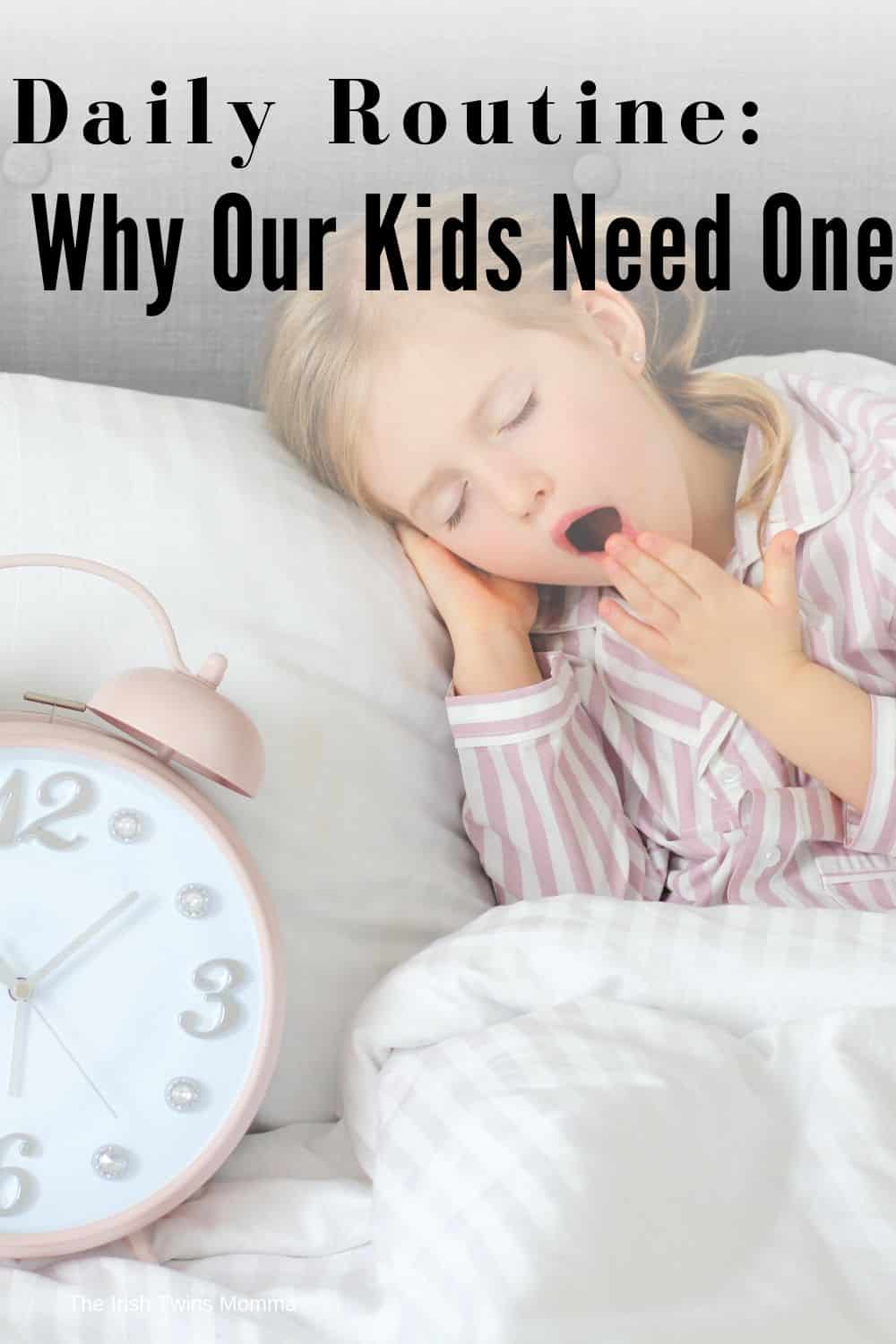This post contains affiliate links. If you click and buy, I may make a commission, at no cost to you. See my disclosure policy for more information.

As parents, too often we focus on getting from point A to point B (in this case, from wake-up to bedtime) without giving too much thought to routine. I know what you’re thinking: “plan, schedule, routine – oh my!” No matter how type-A you are, achieving a daily regimen can feel overwhelming and stuffy. But experts far and wide continue to argue that both children and parents benefit from a more structured, predictable family routine.
I’m here to show you that it’s possible to carve out a routine that works for your family, without becoming so rigid and scheduled that you feel trapped. The purpose of developing a routine isn’t just to manage your family’s time well (though it’s a BIG plus).A routine also has a positive impact on your child in many ways and can contribute to their wellbeing, development, and physical and emotional health.
Routines have been proven to:
- Promote a calm household with reduced stress and anxiety
- Create a sense of control and stability for children who are constantly having new experiences and navigating change
- Teach children how to adapt well to change in the context of a familiar routine
- Encourage independence and self-efficacy
- Provide a safe foundation that helps to mitigate stress and allows children to feel confident in themselves and their surroundings, making them more likely to explore their curiosities and interests
- Establish household rules and norms that children will expect and will, therefore, be less likely to resist
- Teach life skills, responsibility, and healthy habits
- Preserve time for precious family moments and memories
- Ensure children get enough sleep and eat timely meals and snacks
- Set an example for children as they develop their own structure and routine later in life
Of course, the advantages of developing routines go far beyond those that I’ve listed, but these are some of the benefits I’ve experienced in my household. Let’s break a typical day at home into three parts: morning, midday, and bedtime.
MORNING ROUTINE
Your routine should begin from the moment your child wakes up. Ensuring their morning has a structure with positive energy can set the tone for the remainder of the day. One way to help make your morning routine easier is to prepare the night before — pick out your child’s clothes, figure out breakfast (and do prep work if possible), and plan and prepare crafts and other activities. In order for your child’s day to have smooth transitions, you have to plan your personal tasks, as well — so pick out your own clothes the night before, set the coffee maker on a timer, and determine how you’ll weave your errands and chores into your family’s routine.
MIDDAY
Once your morning routine is complete, your family will transition into your day’s activities. Think of each part of your routine as an opportunity for your child to learn, grow, and explore. What may seem like a simple, mundane task for a parent can be much more for a child. For example, a toddler’s playtime can be used to learn how to take turns, share, and clean up, while snacktime can be used to socialize as a family and learn new words. Try to incorporate small rituals throughout the day, as well, that help you connect with your child and give them a sense of comfort and love, like holding hands while walking down the stairs or listening to music and dancing together.
BEDTIME
The evening is usually when families slow down and decompress after a busy day, but it can still involve a structure that leads into a timely, smooth bedtime routine. Try to serve dinner around the same time every night so you leave enough time for your pre-bed wind-down routine before turning out the lights. Bathtime, getting dressed in pajamas, brushing teeth, and reading books are all activities that signal to your child’s body clock that it is time to prepare for sleep. There’s also an opportunity for implementing some teachable moments. For example, if you have school-aged children, taking this time to debrief about their day at school can help their communication skills, while allowing them to help pick out their clothes for the following day will promote independence and confidence.
Before sharing a couple of sample schedules, now is a good time to mention flexibility. If you’re worried that your family will be doomed if you stray from the routine here and there, and that all your hard work will go out the window, don’t be! In fact, routines should have room for flexibility. Disruptions can’t be avoided, but children respond best to change if they occur within a predictable routine that you’ve laid as a foundation in their lives. In fact, a child with routines adjusts better to regular day-to-day changes as well as more stressful situations. Make sure to keep your cool during interruptions to your routine, no matter how frustrating they are — this behavior will teach your child how to properly adapt.
Sample Routine for Toddler
Toddlers thrive in repetition, and those with consistent schedules are more likely to get great sleep. Having a solid sleeper isn’t just about giving parents a break; well-rested children get through their days feeling happy and content. And what’s the best way to make sure you’re toddler is sleeping enough? Routine! Children with predictable routines leading up to naps and bedtime are less likely to resist, falling asleep easier and sleeping longer. Even at this age, you can incorporate rituals that teach good habits and independence, such as washing hands before eating or picking out which book they would like to read.
Here’s a basic daily toddle routine:
7:00 am: Wake up
7:30 am: Eat breakfast
8:00 am: Brush teeth, get dressed
8:15 am: Playtime, read, music
9:15 am: Go outdoors (walk, yard, playground)
10:15 am: Morning snack
10:30 am: Crafts (here are some summer crafts to help you quench your creative juices)
11:30 am: Lunch
12:00 pm: Play in the bedroom, read
12:30 – 3:00 pm: Nap
3:30 pm: Snack
4:00 pm: Playtime, go outdoors
5:00 pm: Read, music
5:30 pm: Dinner
6:30 pm: Bathtime
6:50 pm: Brush teeth, get dressed, read
7:00pm: Lights out
As your child transitions out of toddler-hood, you can adapt your routine to their age by taking away their nap and adding age-appropriate activities. You can also incorporate more elements into their routine that teach self-discipline and responsibility, such as helping to clear the table or feeding the family pet. Your child’s daily routine could look like this:
7:00 am: Wake up
7:45 am: Eat breakfast
8:30 am: Brush teeth, get dressed
8:45 am: Independent play
9:30 am: Go outdoors (walk, yard, playground)
10:15 am: Morning snack
10:30 am: Crafts (this post has crafts for all ages)
11:30 am: Read
12:00 pm: Lunch
12:30 pm: Quiet time
2:00 pm: Playtime, crafts, music, go outdoors
5:00 pm: Quiet time
5:30 pm: Dinner
6:30 pm: Bathtime
6:50 pm: Brush teeth, get dressed, read
7:00 pm: Lights out
What about school days?
The key here is maintaining morning and nighttime routines as much as possible. The best way to prevent rushed and chaotic mornings is to stick with your family’s calm, structured morning schedule. Continue doing what you can the night before to prepare, such as packing your child’s backpack, and make adjustments that allow you enough time to get out the door without becoming frantic. This could mean putting your child to bed a bit earlier so that wake-up is earlier. You also want to preserve your family’s calm wind-down routine, which will promote restful sleep and set your child up for a successful day ahead.
It may seem like your busy life chock-full of parental responsibilities will not lend itself well to routine and structure. However, predictable routines actually provide children a foundation that encourages stability and calm and allows families to make the most of every moment in their day. Among many benefits, children with structure thrive in their environments, learn independence and life skills, and feel a sense of security and control despite new experiences and stressful challenges they encounter. In addition, schedules will help you, as the parent, set and maintain expectations and rules that your child will be less likely to resist. An ideal routine is flexible and can yield to occasional disruptions, allowing your family to deviate from the schedule when necessary.
Developing a routine may feel overwhelming, but once you’re in the groove, it actually has the opposite effect and will provide your family a sense of stillness within an otherwise chaotic life — all while contributing to your child’s growth and wellbeing. I hope this information helps you develop an effective daily routine that works for your child and family!
Sincerely,





Rosslyn
Great tips for routine for the little ones. It is definitely important for them to have stability.